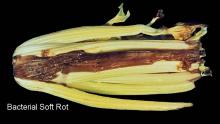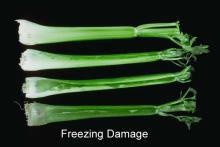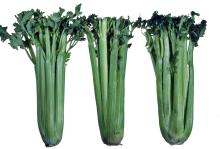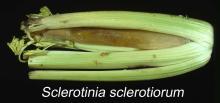Maturity and Quality
Celery is harvested when the overall field reaches the desired marketable size and before the outer petioles develop "pithiness" (see Pith Breakdown below). Celery has very uniform crop growth and fields are harvested only once and stalks are packed by size after trimming outer petioles and leaves.
High quality celery consists of stalks which are well formed, have thick petioles, are compact (not significantly bowed or bulging), have minimal petiole twisting, and have a light green and fresh appearance. Additional quality indices are stalk and midrib length, freedom from defects such as blackheart, pithy petioles, seedstalks, cracks or splits, and freedom from insect damage and decay.
U.S. Grades: Extra No. 1; No. 1; No. 2 (Grade Standards established 1957)
Celery may be sold as "Unclassified" to designate a lot which has not been graded within U.S. standards.
Postharvest Handling and Storage
0°C (32°F)
At optimum conditions, celery should have good quality after storage up to 5 to 7 weeks. Commonly, celery is rapidly pre-cooled and then stored at 0 to 2°C (32 to 36°F). If storage is intended to be less than one month, storing celery at 5°C (41°F) is not recommended for more than 2 weeks in order to maintain good visual and sensory quality. Some continued growth of inner stalks will occur postharvest at temperatures >0°C (32°F).
| Temperature | ml CO2/kg·hr |
| 0°C (32°F) | 3 |
| 5°C (41°F) | 5 |
| 10°C (50°F) | 12 |
| 15°C (59°F) | 17 |
| 20°C (68°F) | 32 |
To calculate heat production multiply ml CO2/kg·hr by 440 to get Btu/ton/day or by 122 to get kcal/metric ton/day.
Celery is not very sensitive to exogenous ethylene at low levels and low temperatures. Loss of green color can result from exposure to 10 ppm or higher ethylene concentrations at above 5°C (41°F).
98-100% R.H.
Controlled or modified atmospheres offer moderate benefit to celery. Delayed senescence and decay development have been observed at 2-4% O2 and 3-5% CO2.
Injury from low O2 (<2%) or elevated CO2 (≥10%) will induce off-odors, off-flavors, and internal leaf browning. CA for mixed storage or long distance transport of celery and lettuce has some commercial application. Elevated CO2 levels delay leaf yellowing and decay but could not be used in mixed loads with lettuce (lettuce does not tolerate CO2 enriched atmosphere).
Disorders
Blackheart. Internal leaves develop a brown discoloration which eventually becomes deep black. The cause is similar to tip-burn of lettuce or blossom-end rot of tomato. Although many predisposing factors may be involved, water-stress results in a calcium deficiency disorder causing cell death.
Brown Checking. Splits, primarily along the inner surface of the petioles result from boron deficiency.
Freezing Injury. Freezing injury will be initiated at -0.5°C (31.1°F). Symptoms of freezing injury include a watersoaked appearance on thawing and wilted leaves. Mild freezing causes pitting or short streaks in the petiole which develop a brown discoloration with additional storage.
Pith Breakdown. The breakdown of the internal tissue of the petiole, the pith, is often refereed to as "pithiness" or pithy stems. The aerenchyma tissue of the petiole becomes white, spongy or vacuolated, and appears dry. Pith breakdown is induced by several factors that result in the induction of senescence, including cold stress, water stress, pre-bolting changes (seed stalk induction), and root infections. Pith breakdown will develop after harvest, but slowly under proper storage conditions.
Crushing or cracking. Common and leads to rapid browning and decay. Harvesting, packing and handling should be done with great care to prevent damage to the highly sensitive turgid petioles.
Diseases are an important source of postharvest loss, particularly in combination with rough handling and poor temperature control. The major bacterial and fungal pathogens that cause postharvest losses in transit, storage, and to the consumer are Bacterial Soft-Rot (primarily Erwinia and Pseudomonas), Gray Mold (Botrytis cinerea), and Watery Rot (Sclerotinia spp.). Botrytis and Sclerotinia will develop over a period of a few weeks, even at 2°C (35.6°F).
Special Considerations
Cut petioles of celery, as for fresh-cut, are very prone to bacterial decay. Less decay and greatly delayed decay symptoms will result from the use of sharp blades, minimizing abrasions or other damage to cut-ends during packaging, and good sanitation.








